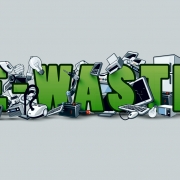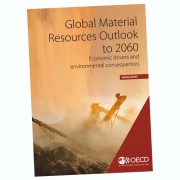Logistics as Key Enabler for a Circular Economy
Future challenges in logistics and supply chain management: A whitepaper, published by Fraunhofer Institute for Material Flow and Logistics, introduces logistical trends supporting the transformation towards a Circular Economy.
The principle of the Circular Economy is to keep raw materials as long as possible within the economic cycle generally free from waste and emission. To do so, end-of-life products and materials must be kept at the highest possible level of value creation according to their original use. To realize such a circular way of economy adapted logistic concepts to coordinate both material and information flow are inevitable – besides approaches to product design for recycling and new business models.
According to the German Fraunhofer Institute for Material Flow and Logistics (Fraunhofer IML), developments of digitization, Industry 4.0 and Internet of Things offer solutions that have not yet been applied to a large extent. “However, possible disadvantages of Circular Economy like rebound effects and increased demand for resources by deploying digital technologies must be taken into consideration,” the specialists say. “Due to its strong integration into the processes of production, use and waste management logistics, in particular, has to contribute to a sustainable economy.”
Logistics in the Circular Economy
In the Circular Economy, logistics has to fulfill more than classic take-back and disposal logistics of today’s waste management services, the authors of the whitepaper – Verena Fennemann, Christian Hohaus und Jan-Philip Kopka – emphasized. Information and communication technologies would allow the integration of all actors along the value chain and enable new business models.
“Up until now, logistical value creation networks have been characterized by a linear flow of materials, culminating in the disposal of goods associated with considerable material and resource losses. This practice creates high amounts of materials and value losses across an entire economic system.” Within this system, logistics were divided into two parts: The “classic” logistics functions support procurement, production logistics and distribution of new parts and products whereas waste disposal logistics focusses on processes at a product’s end of life. The utilization phase between the production of consumer and industrial products and the processes of waste management constitutes a kind of intermediate stage that causes a change of ownership and disrupted information flows within the products life. End-of-life products together with their inherent information, components and raw materials are less effectively recycled as it would be possible within in an effective Circular Economy. In addition, supply chains mainly focus on the production and distribution of non-durable goods and only rarely aim at closing loops in order to repair products. However, one of the most significant challenges in the transformation towards the Circular Economy is the integration of the recyclers as suppliers of high-quality secondary products, components and raw materials on the one hand and the manufacturers buying these materials and offering repair services on the other hand. “In this respect, logistics is one, if not the most important factor of success,” the authors are convinced.
Three Scenarios
“Current efforts towards a Circular Economy are mostly politically driven and still early stage,” the authors state. “No certain forecast is possible as to how legislative conditions will change over the coming years and how markets will react to it.” For this reason, the authors propose scenarios and describe the implications of legislative circumstances on market participants and logistics. The first scenario imagines a more conservative follow-up of current efforts and therefore proposes an only less ambitious transition towards a Circular Economy. The second scenario describes a much more politically driven transformation: In analogy to the German turnaround in energy policy following the Fukushima accident in 2011, the scenario anticipates a legislative framework that is more ambitious in driving enterprises towards a Circular Economy.
Furthermore, there is a third scenario, which is dedicated to a full circular transformation. In this scenario, the European legislation aims at a consequent and global transformation towards a Circular Economy. Resource consumption is sanctioned (e.g. by resource taxes) and additional regulative policies are installed (e.g. consumption taxes) to prevent rebound effects. A set of appropriate circularity indicators to quantitatively and qualitatively assessing resource consumption and resulting environmental impacts are applied. Within EU member states mandatory aims are set, and sanctions are imposed for countries and actors not achieving the aims. Market actors will react adaptive at first, but quickly embrace the new regulations and develop innovations according to the changed market environment.
According to Fraunhofer IML, this third scenario illustrates a substantial shift in the principles of industrial production towards an increase of the importance of repairing and maintenance at the cost of selling new products. “As a result, the overall smaller amount of waste is recycled to higher quality secondary raw materials,” the authors predict. “Export volumes of finished goods decrease as well as the import volumes of raw materials and semi-finished products.” The increase in mandatory obligations would pose a significant challenge for manufacturing companies and their business models. Decreasing sales volumes for new products (in some cases compensated through the selling high-value products) would lead to shifts within the market. “Rising demands for repair work and spare parts (driven by manufacturers, retail and third parties) requires new approaches through existing or new market participants. Requirements for long time spare part supply change drastically (e. g. in terms of backward compatibility of components and parts).”
In the future, manufacturing companies will cooperate more closely with increasingly specialized disassembly and recycling industries or integrate these parts of the value chain. Augmented reality (AR) and virtual reality (VR) applications support repair and disassembly processes. Incorporating secondary raw materials into their products becomes more attractive for manufacturers while high data transparency becomes consensus. The recycling industry will face a market shakeout. “In total, quantities of waste generated and circulated will decrease while the quality of the materials within the stream increases. Recycling companies tend to specialize and integrate more closely with the supply chains of manufacturing industries. They extend their business to new areas in order to better compete with manufacturers (e.g. in the field of refurbishing used parts).” Waste disposal logistics would move towards managing and disposing of residual and hazardous waste.
The logistics industry will change as well, the authors prognose. “Traditional” applications in parcel and bulk goods logistics decrease in market share – especially in the fields of waste disposal logistics and resource distribution logistics. Specialized solutions for small quantities (e. g. used products and spare parts) have good market perspectives. The overall resource consumption of logistics systems and businesses has to be reduced considerably. “Supply chain networks provide a decentralized, comprehensive information infrastructure allowing companies interacting with one another to align their decisions with overarching goals of circular supply chains as well as to their own strategy and societal demands.” Standardized and quality controlled secondary raw materials can be obtained from various sources and are integrated with the procurement strategies of supply chains. The data infrastructure helps to comprehend the origin and quality of materials through the supply chains in an accessible manner. Principles of the Industry 4.0 are applied on company scale and support autonomous planning of logistics tasks by aligning underlying systems with the requirements of new and efficient spare part strategies and on demand-production of components. Companies within the Circular Economy rely more strongly on AR and VR technologies to support workers during the disassembly of products and part harvesting from devices. Products are identifiable by smart labels and autonomously find their routes within logistics networks.
The scenarios describe contrasting ideas of a Circular Economy, the authors conclude, and state that no actual prognosis can be made how and how quickly the development of a Circular Economy will take place in the EU. “On the one hand, a continuation of the existing path beyond the status quo is likely. On the other hand, a disruptive transformation towards a Circular Economy is unlikely to happen over-night. A variety of transitional scenarios can be anticipated, in which existing approaches will be refined, and new ideas will come to fruition,” the experts from Fraunhofer IML predict.
The white paper can be downloaded at http://publica.fraunhofer.de/dokumente/N-502288.html.
Photo: Tsung-lin Wu | Dreamstime.com
GR 3/2018










